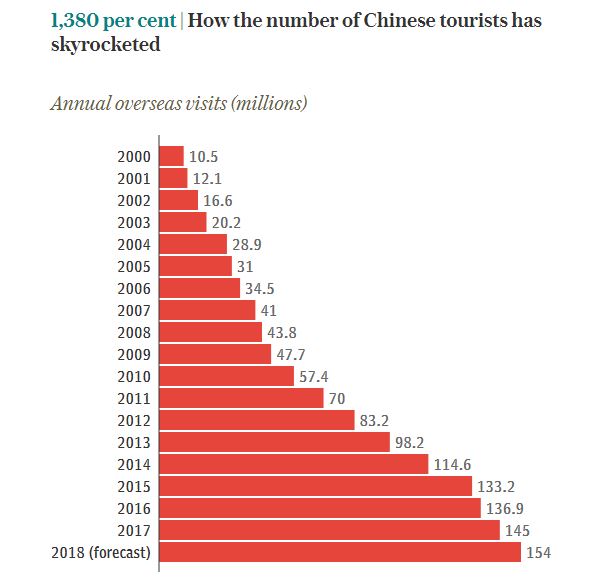Guest Post by Dr.Berenice Pendzialek, Chinese Tourism Specialist
We are pleased to finalize our China Outbound Tourism article series with this great topic on how to maximize available digital channels in order to reach Chinese tourists in their journeys, from planning to booking. 2018 is the EU – China Tourism Year, therefore, we wanted to cover the topic comprehensively with the help of an expert.
Chinese tourists, especially young-independent travelers, are known for thoroughly planning their trips in advance. Much of this pre-trip homework starts 1-2 months before departure and is happening online. According to Hotels.com, Chinese tourists spend 12 days researching online and visit at least one online price comparison site. Moreover, when booking, millennials are keen to use their mobiles, whereas, older travelers choose traditional booking methods (desktop, phone calls, physical visits). Taking this into consideration, it is necessary to let Chinese tourists know about your brand before reaching a destination. This blog post will introduce you to some of China´s digital platforms, that tourism providers can use to create brand awareness, communicate, and offer customer service.
Please note that before sharing information, do plan a consistent content strategy. Start with a proper Chinese name. It is always advisable to look if former Chinese visitors are discussing your product online, maybe they have already created a name for it, then you can decide if using it or have a new one. Reviews are also a good source of future content messages, Baidu Travel Forum can be a good start for your search.
Travel websites and blogs continue to be the most-used resource for Chinese tourists to plan their trips overseas (51% of FGRT respondents used this resource in 2017, followed by 21% usage of social media).
For your own website, simple translations will not be enough to attract a Chinese audience.
To make it China-ready you should:
- Host and register your website in China. Having a .cn address helps you to avoid the slow loading time per page due to China´s Firewall and to comply with China´s government regulations by having an Internet Content Provider (ICP) License. If not having a business license in China, you might need an agency to do this registration for you.
- Have a mobile or responsive version working. As mentioned in the first blog of this series, 80% of Chinese netizens are mobile internet users.
- Link your website to Chinese social media channels.
- Adapt content and marketing messages. Offer tips and recommendations, information on accepted Chinese payment methods, and try to awake emotions with storytelling.
- Increase visibility via SEO. Baidu is by far the most used search engine in China ( 77% market share vs. 10% of Google China ) and offers advertisements similar to Google. However, you should consider registration and verification of your account and an initial payment of 50.000 RMB for a package. Same as with a .cn website, you need an agency to do this paperwork if not having a business license in China.
Other sources of information and booking platforms are online tour operators (OTA) like Ctrip, Qunar, and eLong; travel e-Commerce sites like Tuniu and vertical travel websites like QYER, Mafengwo, and China’s TripAdvisor. The latter relies heavily on user-generated content (UGC) in the form of travel diaries and itineraries. For UGC websites you can start by creating a company profile there, share content and manage reviews. OTAs have attractive advertisement packages (banners, joint campaigns) at your disposal.
However, travel services are not exclusive for travel-related sites. It is increasingly common to find travel products on China´s biggest e-commerce sites like Taobao, for example.
Recommended reading: 5 Key Facts You Need to Know About the China Outbound Tourism Market
Video and live-streaming
Increasingly popular are the video and live streaming platforms. According to Mafengwo´s independent traveler report, 42% of Chinese FITs from the post-90s generation get inspiration to travel from video content.
Youku is a source for long-form, professionally made videos. Whereas, Maiopai and Toutiao Video are platforms for short, mainly semi-professional and self-made videos. Short videos and live streaming (for example on Yizhibo) are commonly used in China to promote events, launch products, and give short pieces of information.
News Reading
A key part of the online routines of Chinese netizens is news reading and it is picking up momentum as a source of inspiration for travel. Apps like Jinri Toutiao use artificial intelligence (AI) to offer a list of headlines of articles, videos, and ads that its users (120 million daily active users by Q2, 2017) may find attractive.

Payment Apps
When accepting mobile payments, for example, Alipay, you can open a store (something like a catalog entry) on Alipay´s App. There you can share basic information about your product, location, as well as to offer campaigns. While browsing the app, Chinese tourists receive location-based recommendations of stores that offer Alipay nearby.
Recommended reading: How to Design the Perfect Experience for Chinese Tourists
Conclusion
During the article, you have already noticed that China´s digital ecosystem is quite different from its western counterpart. To start with, there is an exciting competition between the BAT companies (Baidu, Alibaba, Tencent), which speeds up the digitalization of the country with the development of new business models and platforms. It is also to keep in mind, that Chinese apps are not fragmented and usually have many functions in one. Therefore, one cannot just do a simple comparison of a Chinese and a western app. Moreover, the government plays a strong role, and registration and validation of accounts are needed. Considering this, it is strongly recommended to work with an agency that guides you successfully through China’s digital marketing world.
From the impressive numbers that you can see above, this year it is expected that over 154 million Chinese tourists will travel overseas. For a tour and activity provider, capturing this huge opportunity and reaching Chinese tourists should be a top priority. In case you need more questions and want to learn how Regiondo can help you, we are only an email away.
I hope I have passed my enthusiasm towards the Chinese outbound tourism market in this blog series. It will be really exciting to see the development of the market in the following years and help companies to be part of it.






